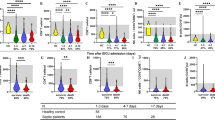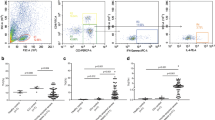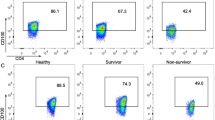ABSTRACT
Circulating lymphocyte number was significantly decreased in patients with sepsis. However, it remains unknown which severity phase (sepsis, severe sepsis, and septic shock) does it develop and what happen on each subpopulation. Eight patients with differing severities of sepsis (31 sepses, 33 severe sepses, and 16 septic shocks) were enrolled. Quantitative real-time polymerase chain reaction (RT-PCR) of Th1, Th2, and Th17; regulatory T (Treg) cell-specific transcription factor T-bet; GATA-3; RORgammat (RORγt); forkhead box P3 (FOXP3); and IL-17 mRNA were performed, and the enzyme-linked immunosorbent assay (ELISA) was used to detect serum interferon (IFN)-γ, IL-4, and IL-10. In this study, the Th1, Th2, Treg transcription factors, and related cytokines IFN-γ, IL-4, and IL-10 levels of sepsis and severe sepsis patients in peripheral blood were significantly higher than those of the normal controls. Except for IL-17, the T-bet, GATA-3, and IFN-γ levels of septic shock patients were lower than those of sepsis patients. We also observed that the proportions of Th17/Treg in the sepsis and septic shock groups were inversed. From the above, the inflammatory response especially the adaptive immune response is still activated in sepsis and severe sepsis, but significant immunosuppression was developed in septic shock. In addition, the proportion of Th17/Treg inversed may be associated with the illness aggravation of patients with sepsis.




Similar content being viewed by others
REFERENCES
Angus, D.C., W.T. Linde-Zwirble, J. Lidicker, et al. 2001. Epidemiology of severe sepsis in the United States: Analysis of incidence, outcome, and associated costs of care. Critical Care Medicine 29: 1303–1310.
Monneret, G., F. Venet, A. Pachot, et al. 2008. Monitoring immune dysfunctions in the septic patient: A new skin for the old ceremony. Molecular Medicine 14: 64–78.
Hotchkiss, R.S., and I.E. Karl. 2003. The pathophysiology and treatment of sepsis. New England Journal of Medicine 348: 138–150.
Limaye, A.P., K.A. Kirby, G.D. Rubenfeld, et al. 2008. Cytomegalovirus reactivation in critically ill immunocompetent patients. JAMA 300: 413–422.
Nishijima, M.K., J. Takezawa, K.K. Hosotsubo, et al. 1986. Serial changes in cellular immunity of septic patients with multiple organ-system failure. Critical Care Medicine 14: 87–91.
Roth, G., B. Moser, C. Krenn, et al. 2003. Susceptibility to programmed cell death in T-lymphocytes from septic patients: A mechanism for lymphopenia and Th2 predominance. Biochemical and Biophysical Research Communications 308: 840–846.
Hotchkiss, R.S., P.E. Swanson, B.D. Freeman, et al. 1999. Apoptotic cell death in patients with sepsis, shock, and multiple organ dysfunction. Critical Care Medicine 27: 1230–1251.
Hotchkiss, R.S., K.W. Tinsley, P.E. Swanson, et al. 2001. Sepsis-induced apoptosis causes progressive profound depletion of B and CD4+ T lymphocytes in humans. Journal of Immunology 166: 6952–6963.
Afzali, B., G. Lombardi, R.I. Lechler, et al. 2007. The role of T helper 17 (Th17) and regulatory T cells (Treg) in human organ transplantation and autoimmune disease. Clinical and Experimental Immunology 148: 32–46.
Ferguson, N.R., H.F. Galley, and N.R. Webster. 1999. T helper cell subset ratios in patients with severe sepsis. Intensive Care Medicine 25: 106–109.
Venet, F., F. Davin, C. Guignant, et al. 2010. Early assessment of leukocyte alterations at diagnosis of septic shock. Shock 34: 358–363.
Wu, H.P., K. Chung, C.Y. Lin, et al. 2013. Associations of T helper 1, 2, 17 and regulatory T lymphocytes with mortality in severe sepsis. Inflammation Research 62: 751–763.
Levy, M.M., M.P. Fink, J.C. Marshall, et al. 2003. 2001 SCCM/ESICM/ACCP/ATS/SIS International Sepsis Definitions Conference. Critical Care Medicine 31: 1250–1256.
Szabo, S.J., S.T. Kim, G.L. Costa, et al. 2000. A novel transcription factor, T-bet, directs Th1 lineage commitment. Cell 100: 655–669.
Zheng, W., and R.A. Flavell. 1997. The transcription factor GATA-3 is necessary and sufficient for Th2 cytokine gene expression in CD4 T cells. Cell 89: 587–596.
Ivanov II, B.S., L. Zhou McKenzie, et al. 2006. The orphan nuclear receptor RORgammat directs the differentiation program of proinflammatory IL-17+ T helper cells. Cell 126: 1121–1133.
Hori, S., T. Nomura, and S. Sakaguchi. 2003. Control of regulatory T cell development by the transcription factor Foxp3. Science 299: 1057–1061.
Zedler, S., R.C. Bone, A.E. Baue, et al. 1999. T-cell reactivity and its predictive role in immunosuppression after burns. Critical Care Medicine 27: 66–72.
Heidecke, C.D., T. Hensler, H. Weighardt, et al. 1999. Selective defects of T lymphocyte function in patients with lethal intraabdominal infection. American Journal of Surgery 178: 288–292.
Brunialti, M.K., M.C. Santos, O. Rigato, et al. 2012. Increased percentages of T helper cells producing IL-17 and monocytes expressing markers of alternative activation in patients with sepsis. PLoS One 7: e37393.
Ono, S., A. Kimura, S. Hiraki, et al. 2013. Removal of increased circulating CD4 + CD25 + Foxp3+ regulatory T cells in patients with septic shock using hemoperfusion with polymyxin B-immobilized fibers. Surgery 153: 262–271.
Leng, F.Y., J.L. Liu, Z.J. Liu, et al. 2013. Increased proportion of CD4(+)CD25(+)Foxp3(+) regulatory T cells during early-stage sepsis in ICU patients. Journal of Microbiology, Immunology and Infection 46: 338–344.
Pachot, A., G. Monneret, N. Voirin, et al. 2005. Longitudinal study of cytokine and immune transcription factor mRNA expression in septic shock. Clinical Immunology 114: 61–69.
Flierl, M.A., D. Rittirsch, H. Gao, et al. 2008. Adverse functions of IL-17A in experimental sepsis. FASEB Journal 22: 2198–2205.
Bosmann, M., F. Meta, R. Ruemmler, et al. 2013. Regulation of IL-17 family members by adrenal hormones during experimental sepsis in mice. American Journal of Pathology 182: 1124–1130.
Chen, Z., and J.J. O’Shea. 2008. Th17 cells: A new fate for differentiating helper T cells. Immunologic Research 41: 87–102.
Vernal, R., and J.A. Garcia-Sanz. 2008. Th17 and Treg cells, two new lymphocyte subpopulations with a key role in the immune response against infection. Infectious Disorders Drug Targets 8: 207–220.
Tang, Q., and J.A. Bluestone. 2008. The Foxp3+ regulatory T cell: A jack of all trades, master of regulation. Nature Immunology 9: 239–244.
Le Tulzo, Y., C. Pangault, A. Gacouin, et al. 2002. Early circulating lymphocyte apoptosis in human septic shock is associated with poor outcome. Shock 18: 487–494.
ACKNOWLEDGMENTS
This study was supported by the Beijing Municipal Science & Technology Commission Program (program number Z11110706730000, project number Z111107067311029) and the National Natural Sciences Foundation of China (Grant No.81172800). The authors thank the nurses of RICU/SICU/EICU at the Chinese PLA General Hospital for their work in this study.
Author information
Authors and Affiliations
Corresponding authors
Additional information
Jia Li and Ming Li contributed equally to this work and should be considered co-first authors.
Rights and permissions
About this article
Cite this article
Li, J., Li, M., Su, L. et al. Alterations of T Helper Lymphocyte Subpopulations in Sepsis, Severe Sepsis, and Septic Shock: A Prospective Observational Study. Inflammation 38, 995–1002 (2015). https://doi.org/10.1007/s10753-014-0063-3
Published:
Issue Date:
DOI: https://doi.org/10.1007/s10753-014-0063-3




